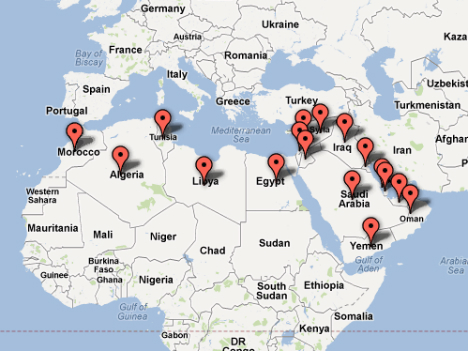Demographics and Unrest
13 Jun 2012
By Schuyler Null for Environmental Change and Security Program (ECSP)
“Countries that have a high proportion of young people are typically more prone to political violence,” said demographer-in-residence at the Stimson Center, Richard Cincotta, in this interview with ECSP. “That is, not necessarily international war [but] internal conflict, which may take different forms,” including civil and ethnic strife, domestic terrorism, and violent political demonstrations.
The role of external pageunemployedcall_made and external pageangry youthscall_made in the recent unrest that has swept the Middle East has received a great deal of coverage, but though the region in general is very young, some countries are more so than others.
Tunisia (median age of 29) is actually well into its demographic transition, where fertility declines towards replacement level. “Fertility – the number of children women have in their lifetime – is now lower than it is in the United States,” said Cincotta. As a result, Tunisia’s prospects for achieving a stable, liberal democracy – based on the historical relationship between age structure and political freedoms (see Cincotta’s external pagefull post on Tunisiacall_made and the external pagetwocall_made external pagefollow-upscall_made for a more complete treatment of that relationship) – are about even.
In contrast, external pageEgypt’s age structurecall_made remains young (median age of 24) and Yemen’s (median age of 17) is external pageextremely youngcall_made.
“Those difference are very stark,” said Cincotta, and they play out in the risk of political violence: Tunisia is less likely to experience continuing political violence; Egypt, more so; and external pageYemencall_made, even more likely.
The relationships between external pageage structure and political violencecall_made and the external pageemergence of democratic institutionscall_made can be useful in other conflict-prone regions as well. “external pageAfghanistancall_made external pagePakistancall_made, external pageIraqcall_made, the Palestinian Authority, most of the central band of sub-Saharan Africa – from external pageNigeriacall_made to the external pageCongocall_made, to external pageKenyacall_made and external pageEthiopiacall_made– we know that these countries are volatile, we’re not always sure why,” said Cincotta. But “age structure gives you a clue, because it tells you something about a lot of barriers that are important to development.”
To illustrate the points made by Richard Cincotta, we conclude by mapping the demographics of the Middle East and North Africa. Please click on the map below to enlarge.


